It’s a well-known fact that most birds can fly. Some birds fly to catch prey, while others fly to escape predators. Regardless, the ability to fly is one of the defining features of most birds. However, there exists a subset of birds that lack this ability. There exist a handful of birds that can’t fly at all, and live their entire lives rooted to the ground. While some of these birds have been hunted to near extinction, others continue to thrive and proliferate. In this article, we’ll discuss a handful of these unique birds that can’t fly. So, next time you see one of these particular birds, you’ll know why they’re sticking to the ground. Without further ado, here are 10 birds that can’t fly.
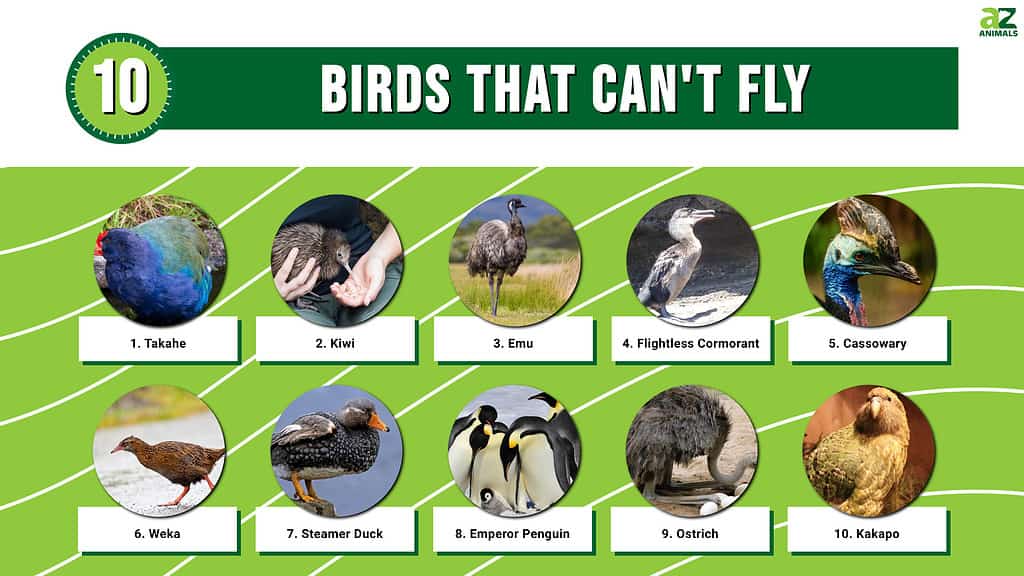
#10: Kakapo
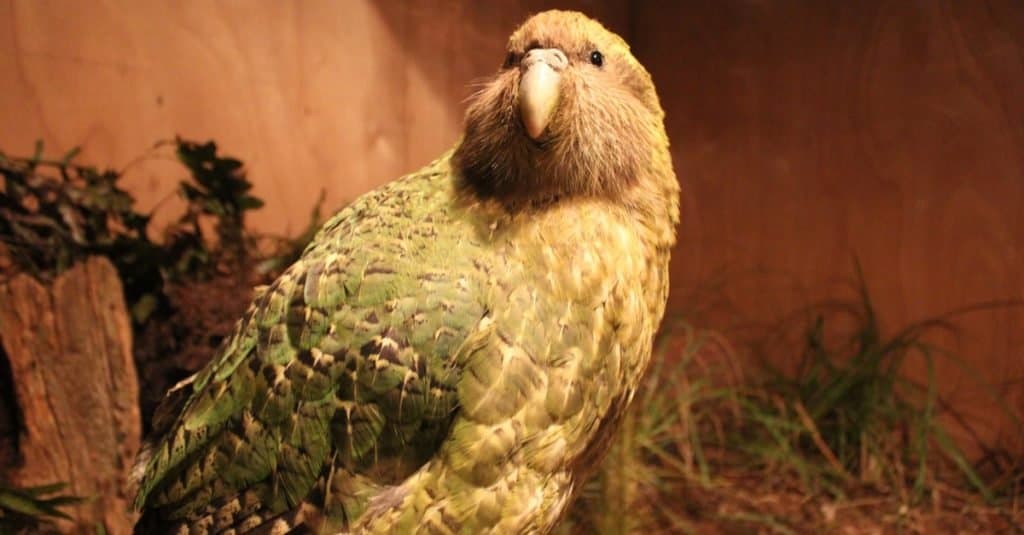
Endemic to New Zealand, the kakapo is the world’s only flightless parrot.
©Imogen Warren/Shutterstock.com
Also known as the owl parrot due to its owl-like features, the kakapo is a large species of flightless parrot. Endemic to New Zealand, kakapos rank as the largest parrots in the world. They range from 23 to 25 inches long and weigh between 2 and 9 pounds. Although they are birds that can’t fly, kakapos excel at climbing trees. On occasion, they will also use their wings to glide short distances after jumping from high elevations. Their plumage appears greenish-yellow, and they sport a large beak and feet. Kakapos are nocturnal and live on a diet of grasses, seeds, gruits, and tree sap. Due to hunting, deforestation, and predation by invasive mammals, kakapos are among the rarest animals on Earth. Currently, only around 200 remain in the wild, all of which live in isolated, predator-free island sanctuaries.
#9: Ostrich
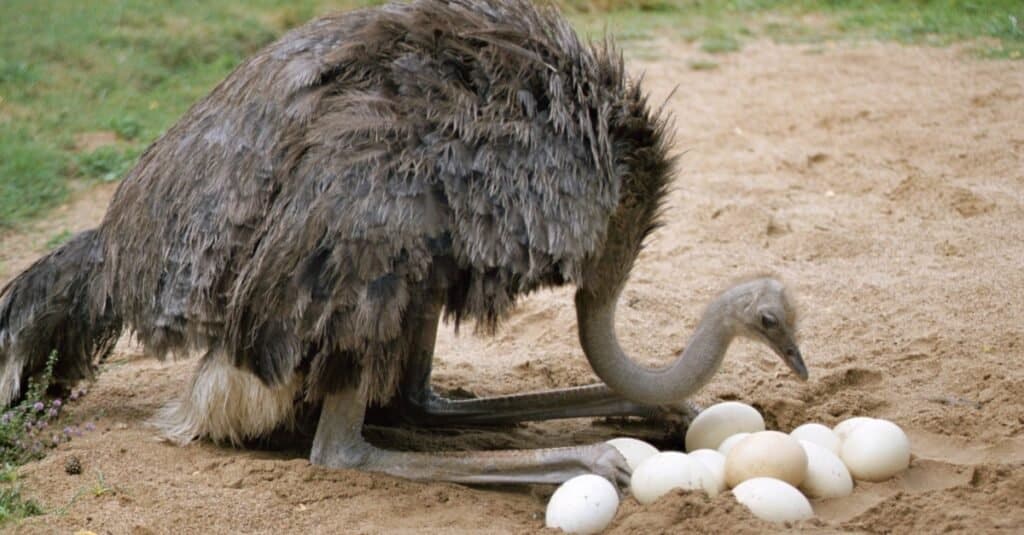
While they can’t fly, ostriches are the fastest runners of any bird or other two-legged animal and can sprint at over 70 km/hr, covering up to 5m in a single stride.
©fullempty/Shutterstock.com
The ostrich is the largest member of the ratite infraclass Palaeognathae and the most massive extant bird in the world. Due to their massive size, their puny wings mean they rank among the birds that can’t fly. However, they still use their wings for balance when running, as well as for courtship displays. Two living species of ostrich remain, both of which live in the wild in Africa, along with commercial farms. Ostriches usually weigh from 139 to 320 pounds and can stand up to 9 feet, 2 inches tall. Their plumage is mostly black, although they sport white tail feathers. They can run up to 43.5 miles per hour, making them the fastest bird on land. In addition, they also lay the biggest eggs of any animal on land. Their diet mostly consists of grasses and plants, although it also eats invertebrates and some reptiles.
#8: Emperor Penguin
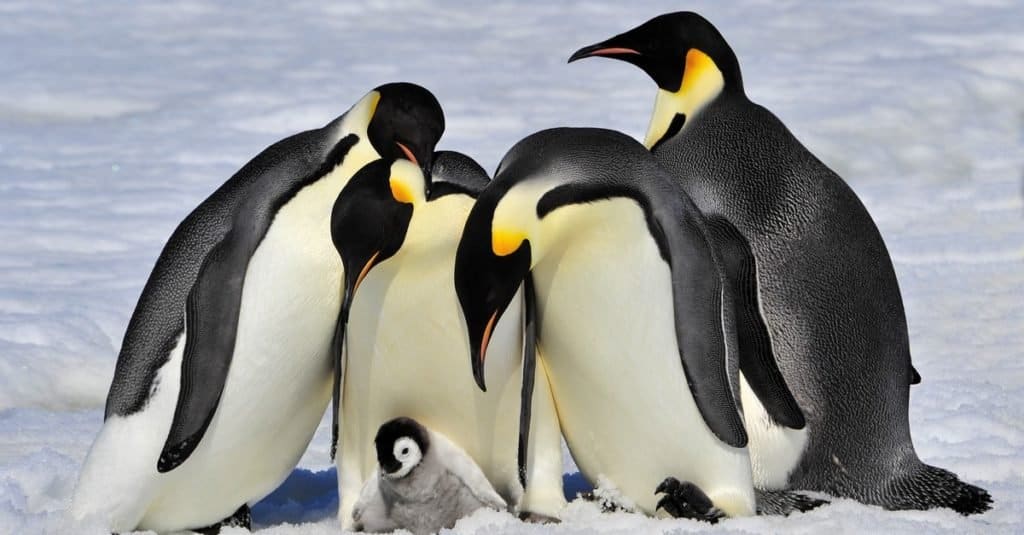
Emperor penguins can’t fly but can swim to depths up to 1,755 feet below the sea surface.
©vladsilver/Shutterstock.com
The emperor penguin is one of the most recognizable birds that can’t fly in the world. Emperor penguins live only in Antarctica and split their time between the coasts and inland. They make one of the most unique migrations in the world, trekking nearly 100 miles inland to breed during winter. Males and females take turns incubating a single egg and feeding young until they can take care of themselves. Emperor penguins rank as the largest penguin species, standing up to 39 inches tall and weighing 49 to 99 pounds. Their plumage appears black on their faces and backs, white on their bellies, and yellow around their necks. Capable of holding their breath for up to 20 minutes, they can dive to depths of 1,755 feet. While submerged, they hunt for food including crustaceans, krill, fish, and squids.
#7: Steamer Duck
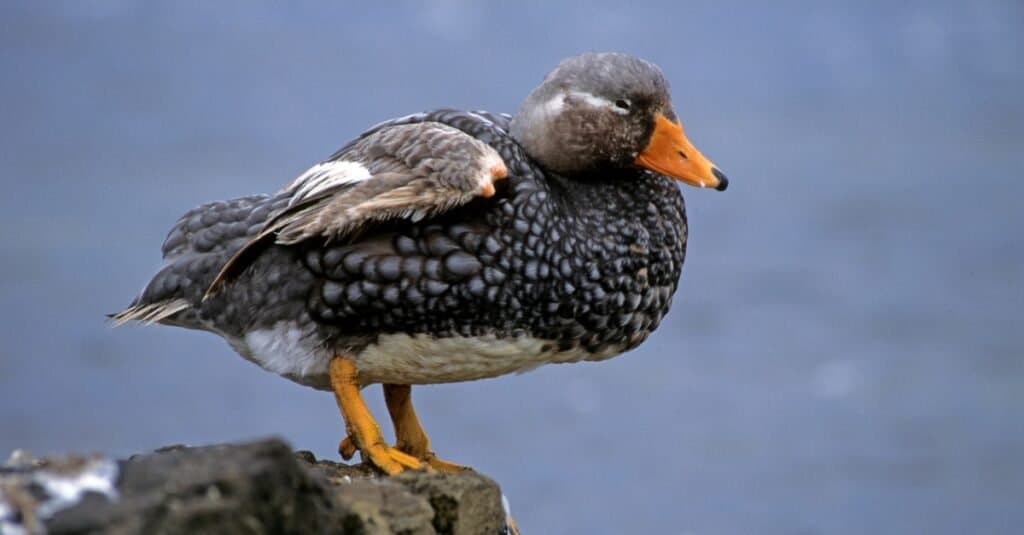
Steamer ducks can’t fly, but they don’t let other birds push them around. They will fight and kill larger raptors and waterfowl.
©iStock.com/Michel VIARD
Steamer ducks get their name from their habit of flapping their wings and feet when in the water. This behavior can make them look like a paddle steamer boat to the casual observer. However, although they flap their wings, they still rank among birds that can’t fly. All four species of steamer duck live in Chile and Argentina at the southern tip of South America. Of the three species, only the flying steamer duck is capable of flight. Known for their large size, steamer ducks typically can measure over 33 inches long and weigh over 15 pounds. They live near rocky coastlines and subsist on mollusks, crustaceans, seeds, small fish, and insects. Steamer ducks can act highly aggressive and frequently engage in violent battles with other steamer ducks. In addition, they will fight off other, large waterfowl and raptors, and may come to the rescue of other species.
#6: Weka
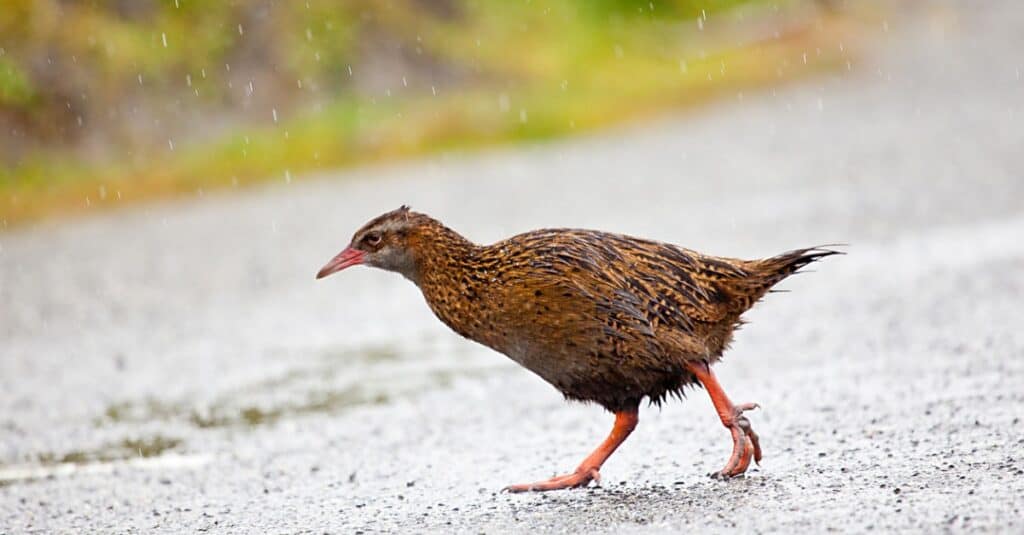
The Weka or wooden is currently listed as Vulnerable due to habitat loss and predation by invasive mammals.
©iStock.com/Dirschl
Another flightless bird from New Zealand, the Weka is part of the rail family. Also known as the woodhen or Māori hen, there exist four different subspecies, although this is hotly debated. Although they possess small, ineffective wings, they adapted strong legs. Their plumage appears brown with shades of black and gray. On average, they measure between 20-24 inches long and weigh from 1.1 to 3.5 pounds. A weka’s tail is small and almost always moving, which is characteristic of other species of rail. They live in forests, sand dunes, rocky coastal areas, and grasslands throughout New Zealand. Their diet primarily consists of grasses, leaves, seeds, and berries. Wekas nest on the ground, and both males and females take turns incubating the eggs. Currently, the IUCN lists them as a Vulnerable species due to predation by invasive predators and habitat loss.
#5: Cassowary
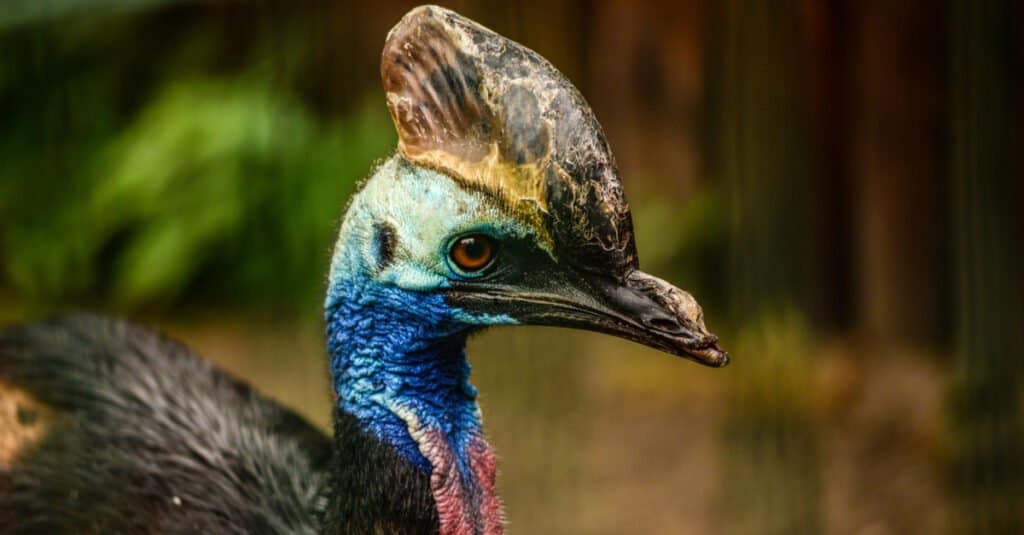
The flightless Southern Cassowary is one of only two birds known to have killed a human.
©studioxy/Shutterstock.com
The cassowary is another member of the long-legged, flightless ratites. Three extant species range throughout New Guinea, northern Australia, and the Aru Islands. Among birds that can’t fly, cassowaries enjoy a fearsome reputation, and also go by the name “world’s most dangerous bird.” This title is earned due to its large size, sharp claws, and aggressive nature when cornered or threatened. They stand between 5 to 6.6 feet tall and can weigh up to 130 pounds. Their small wings end in hard, keratinous quills that look similar to a porcupine’s but without barbs. Cassowaries feature a large golden or blue casque on their heads which grows with age and a blue wattle on their neck. Capable of running up to 30 miles per hour, cassowaries can also jump long distances and swim well. Most of their diet consists of fruits, as well as small invertebrates, birds, rats, and fish.
#4: Flightless Cormorant
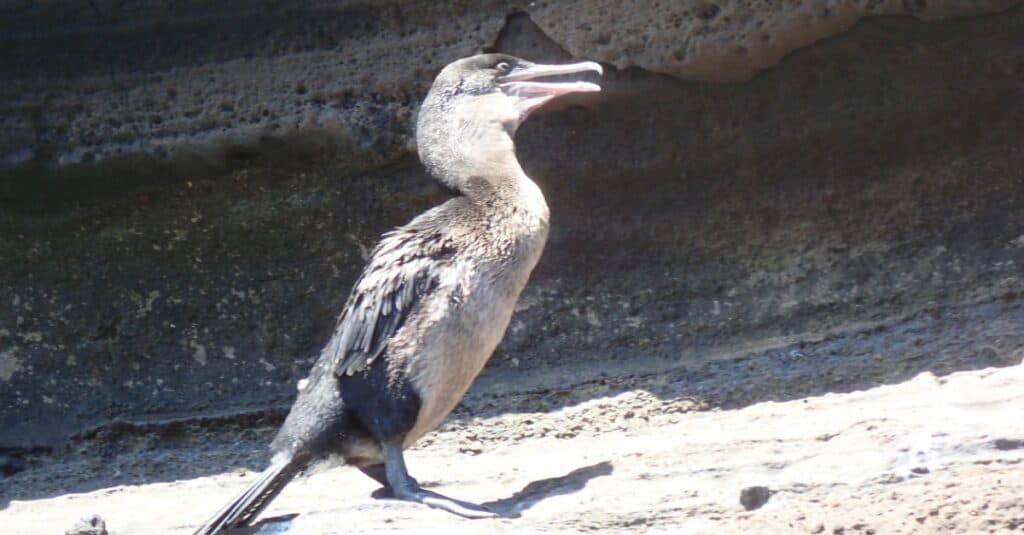
Native to the Galapagos Islands, the flightless cormorant is the only cormorant species that can’t fly.
©iStock.com/Germán Lorenzo Fariña
Also known as the Galapagos cormorant, the flightless cormorant is unique among birds that can’t fly. It’s the only cormorant species that is unable to fly, and also one of the largest cormorants in the world. Flightless cormorants range throughout the Galapagos Islands and some isolated regions of Ecuador. They measure between 35 to 39.5 inches long and weigh from 5.5 to 11 pounds on average. Their plumage appears brownish-black, and they sport a long beak that ends in a sharp hook. In order to fly, their wings would need to grow three times larger than their current size. To move around, they rely on their webbed feet and strong legs to propel them through the water. The diet of the flightless cormorant consists mostly of fish and octopuses. Since they don’t possess waterproof feathers, they must dry off regularly between swimming trips.
#3: Emu
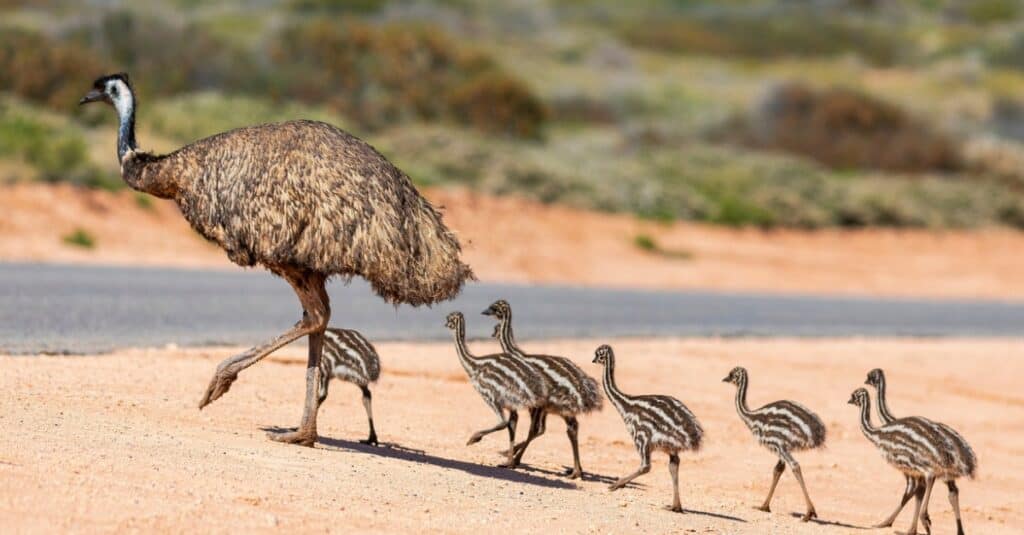
Native to Australia, the flightless emu is the second-largest bird in the world.
©iStock.com/JensenChua
The emu is the second-largest member of the ratites and extant species of bird in the world. They stand between 59 to 75 inches tall and weigh from 40 to 132 pounds. Native to Australia, they range throughout the country’s savannahs and forests, although they tend to avoid arid regions. With their long, powerful legs, they can run up to 30 miles per hour. Their plumage varies according to their environment but generally appears brownish-beige with hints of black and rust. Emus forage during the day and eat a diet of seeds, grasses, fruits, and insects. Unlike most birds, the males are solely responsible for constructing the nest and incubating the eggs. Furthermore, female emus typically act more aggressively than males and may fight over potential mates. While listed as a species of Least Concern, they face threats due to habitat loss, traffic collisions, and invasive predators.
#2: Kiwi

The flightless kiwi is the smallest member of the ratite category of birds.
©K Ireland/Shutterstock.com
An international symbol of New Zealand, kiwis are the smallest member of the ratites. Scientists recognize five different species, most of which face threats due to habitat loss and invasive predators. Among the birds that can’t fly, kiwis adapted some unique features that set them apart. Their wings are so small that they appear barely visible under its hairlike, brown-gray feathers. They sport a long bill with a sensitive nose to help them detect prey and no tail. Although mostly nocturnal, they also come out during the day, especially if they live in sanctuaries. Kiwis mostly live in forests but also adapted to live in scrublands, mountainous regions, and grasslands. They eat a varied diet of small invertebrates and amphibians, worms, insects, fruits, and seeds. Their eggs weigh up to 1 pound, which ranks as one of the largest eggs in relation to body size among all birds.
#1: Takahe
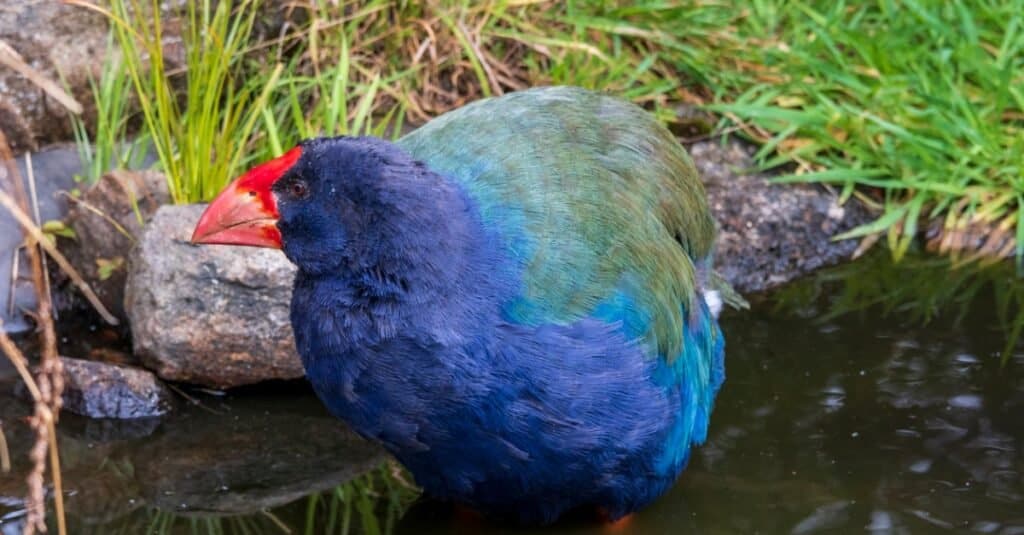
The rare takahe is another flightless bird native to New Zealand. They sport bright blue plumage and large orange beaks.
©iStock.com/Jef Wodniack
Also known as the South Island takahē or notornis, the takahē is native to New Zealand. The largest extant member of the rail family, it’s one of the rarest birds that can’t fly in the world. Once believed extinct in the wild, its population as of 2019 is around 418 individuals. Takahēs can reach up to 25 inches long and can weigh nearly 9.3 pounds. Stocky, powerful birds, takahēs sport huge bills that can deliver a strong bite. Their plumage appears dark blue on the head and belly and lighter blue and green on the wings and back. They live in mountainous grassland regions during the summer and descend to lower elevations in winter. While highly territorial and solitary, takahēs breed for life and can live up to 18 years in the wild. They primarily subsist on a diet of grasses, shoots, and insects, particularly on snow grass.
Summary Of The 10 Birds That Can’t Fly
| Rank | Bird |
|---|---|
| 10 | Kakapo |
| 9 | Ostrich |
| 8 | Emperor Penguin |
| 7 | Steamer Duck |
| 6 | Weka |
| 5 | Cassowary |
| 4 | Flightless Cormorant |
| 3 | Emu |
| 2 | Kiwi |
| 1 | Takahe |
The photo featured at the top of this post is © Harry Beugelink/Shutterstock.com
Thank you for reading! Have some feedback for us? Contact the AZ Animals editorial team.






